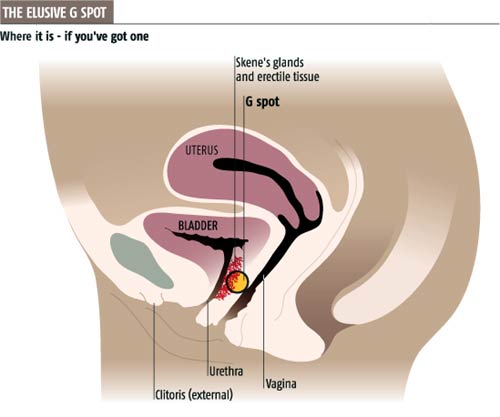Bigger is better when it comes to the G spot
19:00 03 July 2002
Exclusive from New Scientist Print Edition. Subscribe and get 4 free issues.
Nicola Jones
The elusive G spot: where it is - if you've got one
Drugs such as Viagra should work for some women - especially if they have a big G spot. This spot, famed for producing spectacular orgasms, turns out to be awash with the enzymes that these drugs act on.
The term G spot, coined by Ernest Gräfenberg in 1950, refers to an area a few centimetres up inside the vagina on the side closest to a woman’s stomach (see diagram). Buried in the flesh here are the Skene’s glands, the female equivalent of the prostate gland.
In men, the prostate produces the watery component of semen. In women, Skene’s glands are also thought to produce a watery substance that may explain female “ejaculation”. The tissue surrounding these glands, which includes the part of the clitoris that reaches up inside the vagina, swells with blood during sexual arousal. And there’s some evidence that nerves in the area produce an orgasm different to one produced by clitoral stimulation.
Nevertheless, there is still debate about whether the G spot even exists. “Not everyone has accepted this yet,” says Beverly Whipple, a neurophysiologist who co-wrote a book about the G spot in the 1980s. So Emmanuele Jannini of the University of Aquila, Italy, and his team decided to look for biochemical markers of sexual function in the area where the G spot is meant to be. They picked PDE5, an enzyme that chews up the nitric oxide that triggers erections. Viagra works by blocking PDE5.
Researchers had seen evidence of nitric oxide activity in the clitoris before, but no one had actually looked for PDE5 enzymes or knew exactly where they might be. “It’s ridiculous but true that we’ve waited till now to really know the female anatomy,” says Jannini.
Anatomically impossible
He found PDE5 in the vagina of five volunteers, he will report in Adult Urology. Dissections of 14 cadavers revealed that the enzymes were mostly clustered in the G spot. But in two of the subjects with much lower concentrations of PDE5, he couldn’t find any Skene’s glands at all. “For such women, having a vaginal orgasm is anatomically impossible,” he says.
Whipple and others suspect the glands may have been there but were too small to spot. Even so, the small size of the area should make a “G-spot orgasm” unlikely.
The findings suggest that Viagra and related drugs like tadalafil and vardenafil, set to hit the market in a few months, should have the greatest effect on women who have large Skene’s glands and heaps of PDE5. Trials of Viagra in women have so far had mixed results. Some researchers speculate that this is because the women tested had too broad a range of sexual problems, from not reaching orgasm to not wanting sex at all. Jannini’s work suggests that a woman’s anatomy might also make a difference.
Well hidden
“Research in women using these drugs has been hampered by a lack of a framework demonstrating the biochemical processes governing the female sexual response,” says Helen O’Connell of the Royal Melbourne Hospital, Australia, who showed in 1998 that the clitoris is far bigger than anyone thought. “That understanding of the clitoral and vaginal structure and function is developing is great for women.”
So how do you tell if you’ve got a G spot? Sadly, because Skene’s glands are so well hidden by the surrounding tissue, no visual examination can reveal if a women has them or not. Only personal experience can do the trick.
But even for those with a small G spot or none at all, Viagra-type drugs might still have some effect, as PDE5 is found in the clitoris too. And other drugs that stimulate arousal via the brain could soon become available. But Jannini and Whipple both agree that the female orgasm is so complex that drugs alone won’t work for everyone.
Same link as graphic above.
